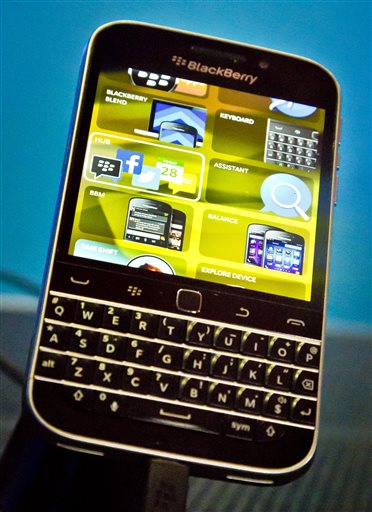NEW YORK (AP) — The BlackBerry’s blinking red light used to haunt me.

Just when I thought I could relax, enjoy a nice dinner or go for a run, my BlackBerry would start blinking again, signaling a new message. I was an addict. Typing with one hand, hiding the BlackBerry under the dinner table? No problem. Walking down the street while composing messages? Easy.
That was four years ago.
Today, I’m a loyal iPhone user, having just bought my second phone from Apple. I get my personal and work email on it. I also use it to tweet — maybe too much — and share photos of my travels on Instagram. My airline boarding passes and hotel reservations live on my phone. As a travel reporter, I find it’s an indispensable tool for my work — not so much for the email but for all the apps that help me manage my trips. It feels like a mobile office for me.
This past week, I went back to my BlackBerry ways to test the company’s latest model, the Classic.
For BlackBerry, this device is a return to its roots: It’s made for those heavy corporate users who love the physical keyboard and have resisted the touch screens adopted by millions of iPhone and Android users. The Classic has strong security features, restores the beloved navigation row and sports a battery that won’t be drained by lunch.
I can see how the Classic is a great device for loyal BlackBerry fans.
My friend Heather Montminy practically jumped out of her chair to try the Classic when she saw me testing it during dinner last week with our respective spouses. Montminy is a lawyer who has been using a BlackBerry for 12 years and carries two phones: an iPhone for her personal use and a BlackBerry for work.
I’m excited for any new BlackBerry. I was really concerned that they were going to phase out the keyboard, Montminy says. I feel like I can get a business email done much faster and more efficiently.
She says she’s not great at typing on a touch screen and often finds herself making mistakes and having to go back and fix them. That might be fine in a message to friends but not on an important work email.
But after four years on the iPhone, I don’t think the Classic is for me. I also don’t believe it’s going to sway back anybody who has abandoned the BlackBerry.
To be honest, I’ve become very good at typing emails on my touch screen. And I’m no casual user.
I send and receive a whopping 500 emails a day. Many are public relations pitches that only require a word or two in reply. But for many others, I will easily respond with a few paragraphs on my iPhone. In fact, I will often write large sections of my stories on my iPhone while riding the subway or sitting on planes prior to takeoff. The only big downside for me is copying and pasting.
Going back to a physical keyboard this past week turned out to be cumbersome. Yes, I liked that while in another program, the BlackBerry gave me a little banner up top announcing the sender of a new email. And, to be honest, that blinking red light was, in a strange way, comforting. But I wasn’t typing any faster with the physical keyboard.
Beyond that, photos aren’t as good as what I can take with the iPhone. Both phones produce 8 megapixel pictures, but images taken with the Classic weren’t as sharp.
More importantly, BlackBerry lacks several apps I’ve come to depend on. The Classic will run some Android apps through Amazon’s app store, but it’s a subset of what’s available for Android. It doesn’t even run everything that would run on Amazon’s Fire phone. Apps need to be tweaked for the phone’s 3.5-inch screen (The display is smaller than most phones because the physical keyboard takes up much of the bottom).
There’s no Instagram, no Uber car service — at least without relying on unofficial apps or complex, backdoor installation methods.
There’s also no ability to easily pull up my airline boarding passes. With my iPhone, I can add my boarding pass to Passbook. It’s there as I get to the security checkpoint — no fumbling around email folders or hoping there is a strong enough cell signal to download the image fresh. With BlackBerry, I can download some individual airline apps, but not all of them work.
There are ways that Blackberry loyalists find to get most of these apps — or at least their functionality through similar apps — but for me, none of that was intuitive. And that’s my issue. I don’t want to think too hard just to use my phone.
Maybe if I never got a taste of the iPhones and all the apps available for it, I’d be first in line for a Classic. But BlackBerry took too long to modernize its system, and in that time, I’ve gotten used to the touch screen.





